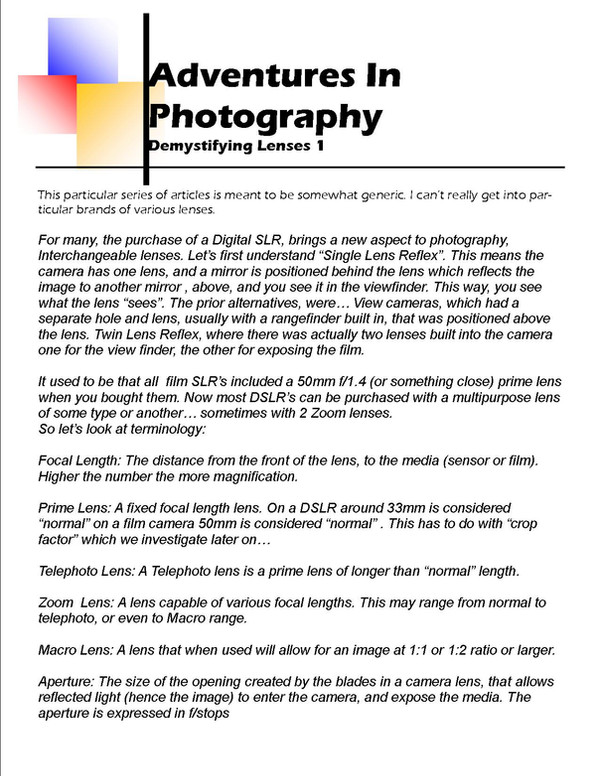HOME | DD
 TThealer56 — Demystifying Lenses Part 1
TThealer56 — Demystifying Lenses Part 1

Published: 2009-04-25 06:57:27 +0000 UTC; Views: 1695; Favourites: 50; Downloads: 59
Redirect to original
Description
Okies!Those 4 people in my poll that didn't want to see anymore of this, DON'T LOOK!
Here's another series that covers some basic information on lenses.
Hope it helps a bit!
Related content
Comments: 19

Take your point in your reply to jon-rista - but I think myself that it might start people (noobs) off on completely the wrong foot to say that longer-than-normal lenses "are" all telephotos. As you know, that's not true (even in 35mm). Okay, we needn't go at all into how "angle of view" is determined by the optical design, but... So can you please say something like the following?
In general, the longer a lens focal length, the narrower its angle of view and the "closer" a subject appears in the viewfinder.
An ordinary lens is physically "as long as" its focal length - so a 50mm lens is about 2 inches (= 50mm) long front-to-back, and a 100mm lens is usually about 4 inches long.
However, for longer lenses the internal design can be arranged so the optical length - the focal length or light path - is actually a bigger distance than the physical length, so a 200 mm lens can still be about 4 inches long in your hand instead of the 8 inches of its focal length. This is called a "telephoto" design. The downside with any telephoto design is that it requires more lens elements inside, so performance (even if outstanding) is never quite as good as a non-telephoto lens of the same focal length.
Wide-angle lenses for SLRs have a different problem: they need to be further away from the film than their focal length requires, in order to clear the reflex mirror when it swings up to take a picture. So their optical centre is behind their physical centre - a 24mm lens (focal length about 1 inch) is usually still about 2 inches long in your hand. This is a "retro-focus" design. Non-reflex cameras don't have this problem, so their wide-angle lenses are mostly very "flat" to the front of the camera, physically echoing their actual focal length.
👍: 0 ⏩: 0

A note about focal length. You noted that it was the distance from the "front of the lens to the to the media (Sensor or film)". That is actually not true. That would be what is called FFL or FFD (Front Focal Length/Distance), and conversely the focusing distance from the back lens element is BFL or BFD (Back Focal Length/Distance).
The actual focal length of a lens has little to do with any particular lens element, and more to do with the distance from the media (sensor or film) where light completely converges into a focal point. This is usually somewhere in the middle of the lens, sometimes even between the back lens element and the media. It is rarely exactly at the front lens element or back lens element. You can do a simple test to verify this....measure the length of your 50mm lens, and it will end up much longer than 50 millimeters.
It is difficult to say exactly where within a lens (or behind it) the focal point may occur, and different lens manufacturers have different standards that dictate how a focal length of 50mm or 135mm or 400mm is determined. However, simply stating that it is the distance from the front lens element to the sensor is inaccurate.
👍: 0 ⏩: 1

Yes, you are in fact correct, as the simple definition (which is the one I gave) only holds true for fixed single element lenses, and is indeed a totally gross over simplification of the subject. Even then it's not all together correct.
We can also realize that a mirror lens of 500mm is not going to be 500mm either!
However, as I mention at the beginning of every tutorial I write. The information given is for beginners. Really the functional point of the obviously brief description of focal length was the simple fact, that the greater focal length, no matter how it is determined, the greater the magnification.
Remember, I'm not debating you here in the least, you are correct, however, it is just this type of thing that has many, many, noobs to DSLR photography, totally perplexed. We get into these discussions where we start talking about unknown exact points of convergence of the light, and all the beginner really wanted to know is "Which lens will give me a close view, a 50mm or a 200mm?"
In actual fact, the focal length is where the light converges. The image plane, or focusing plane is actually farther back and is adjusted (creating sharp focus) by movement of the front lens... which is the reason your 50mm example you gave is correct in that the actual measurement in millimeters is going to be greater. Although in today's lenses, the light may pass through as many as 13 or more elements. 
There's a lot of places in my tutorials where I intentionally don't go into precise detail because it isn't necessary. Hell! I'm boring some of these folks to death already!
Thanks for the comment!
👍: 0 ⏩: 0

I for one am greatful for any all all information to try to understand these things. Thank you.
👍: 0 ⏩: 1

Arty Johnson strikes again!
👍: 0 ⏩: 1

I loved to watch him!!! Yeah, back when I was 2!!!
👍: 0 ⏩: 1

Okay....so maybe I was a little bit older!
👍: 0 ⏩: 1


👍: 0 ⏩: 1

Alice is fixing to send you an e-mail...
👍: 0 ⏩: 1

Good stuff. I didn't actually realise a telephoto referred to a longer than normal prime. 
👍: 0 ⏩: 1

A lot of people get "telephoto" and "zoom" confused.
You're very welcome!
👍: 0 ⏩: 0

Thanks Bob - I am adding these to my computer favourites to read fully later x
👍: 0 ⏩: 1































